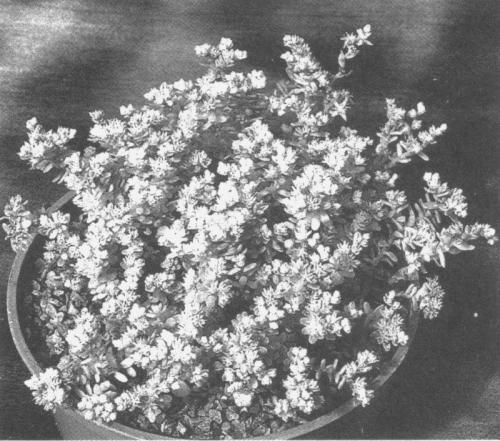JAPONICUM Miquel ssp. JAPONICUM
Synonyms :
Sedum japonicum var. humile Miquel (1866)
Sedum japonicum var. minus Miquel (1866)
Sedum chrysastrum Hance (1870)
Sedum senanense Makino (1902) / Sedum japonicum var. senanse (Makino) Makino (1905) / Sedum uniflorum var. senanense (Makino) H. Ohba (1981)
Sedum japonicum fa. rugosum Fröderström (1924) / Sedum uniflorum ssp. rugosum (Fröderström) K.-T. Fu (1986)
Sedum oryzifolium var. boreale Sugimoto (1965)
Sedum japonicum fa. leucanthemum Honda (1966)
Distribution : China (Sichuan to Guangdong), Taiwan, Japan (Kyushu, Shikoku, Honshu), on rocks near the coast to subalpine and alpine zones, on stone walls or on roofs.
Description (according to IHSP, 2003) :
Differs from ssp. uniflorum :
Without subterranean tubers.
Leaves linear, rarely ovate to orbicular, 5 - 18 x 2 - 3 mm.
Inflorescences : Flowering branches decumbent at the base, to 15 cm, inflorescences cymes with 3 rarely forked cincinni.
This is the most widely distributed and most variable of the subspecies of S. japonicum. Ohba (1981b: 181-187) and Fu (1986: 110) distinguished 2 varieties : Var. senanense from Japan can be distinguished by the small narrow leaves (to 12 x 2 mm) and short flowering shoots (to 6 cm). Var. rugosum from China (Hengduanshan Mts.) differs by the rough stems with flaking bark and very small ovate to orbicular leaves (3 - 5 mm).
Ray Stephenson (Sedum, Cultivated Stonecrops, 1994, pp 160-161) :
Sedum japonicum and Sedum senanense
Common names : Me-no-mannengusa, Miyama-mannengusa
Sedum japonicum is a tufted species growing to 15 cm (6 in) high ; it resembles European S. album but has flatter, brighter leaves, and yellow flowers. Smaller, redder, and more common forms in cultivation tend to be labelled "S. japonicum var. senanense," but they are best referred to as S. senanense. While S. japonicum plants are bright green and more sturdy than plants of S. senanense, the latter have slender, much branched, decumbent, then rising stems that carry alternate, imbricate at first, linear-ovate leaves with spurs in loose tufts. Inflorescences of summer carry many subsessile flowers on three or four branches. Cytological evidence points to keeping the two species separate.
Habitat : Sedum japonicum grows on rocky, open-wooded, lower hillsides on Honshu island, Japan, while S. senanense is from higher altitudes in Honshu - to 2500 m (8200 ft) - often partly shaded.
Main points of distinction : These species are difficult to differentiate from Sedum oryzifolium [= S. japonicum ssp. oryzifolium] in this group and are also similar to larger species in the European S. acre complex. Leaves of S. japonicum and S. senanense are longer than all the leaves of plants of the S. acre group, except for S. sexangulare, which has neat spirals of leaves, and S. urvillei, which has acute leaf apices. Sedum japonicum and S. senanense have blunt, more loosely scattered, reflexed leaves, which are flat on both surfaces. (For ways of differentiating these species from S. oryzifolium, see here .) Sepals of both species are unequal in length, free, and spurred. Epipetalous stamens are inserted noticeably above the bases of petals and are very short. Carpels are erect at first, but then spread widely.
Work by Uhl and Moran (1972) has shown these two species to be cytologically distinct, so they uphold the name Sedum senanense with n = 9. Sedum japonicum has a chromosome count of n = 19 and is a more robust plant than S. senanense. I have not yet acquired a clone that remains pure green when in full sun, but S. japonicum plants are about 6 cm (2 in) tall and only slightly flush with red, even if grown in a very exposed spot. Sedum senanense is bright red for much of the year, and plants do not usually grow more than 4 or 5 centimeters (1 in) high.
Variation : Neither species is particularly common in cultivation, but both respond to situation considerably. Grown indoors, etiolated specimens become uncharacteristic. A species with affinity to Sedum japonicum was collected in Taiwan by the Royal Botanic Gardens Edinburgh and can be found under Sedum sp. RBGE 763791.
Horticulture : These plants make very bright subjects. They tolerate wet conditions if well-drained sites are chosen, but are questionably hardy in areas of long, bitter winters. They are just hardy for me in Mid Northumberland. Sedum senanense is most suitable for alpine cultivation. Neither species grows fast enough for ground cover, as the carpet produced is too open, but both are most attractive in containers and on raised beds.
